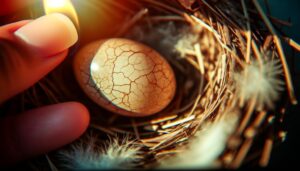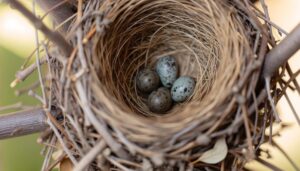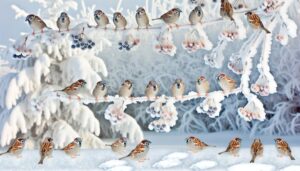Identifying Sparrow Eggs vs Wren Eggs: A Quick Guide
Distinguishing sparrow (Passeridae) and wren (Troglodytidae) eggs entails observing size, coloration, and marking patterns. Sparrow eggs measure 18-22 mm by 13-15 mm, displaying pale blue to white shades with subtle brown speckles.
Conversely, wren eggs are smaller, about 12-16 mm by 10-12 mm, showcasing diverse hues from white to pinkish, often with reddish-brown speckles. Sparrow nests are bulky and cluttered, located in urban settings, whereas wren nests are neater, comprising twigs and feathers, typically found in woody areas.
Understanding these characteristics aids in accurate identification, enhancing observation skills in ornithological studies. For deeper insights, continue exploring.
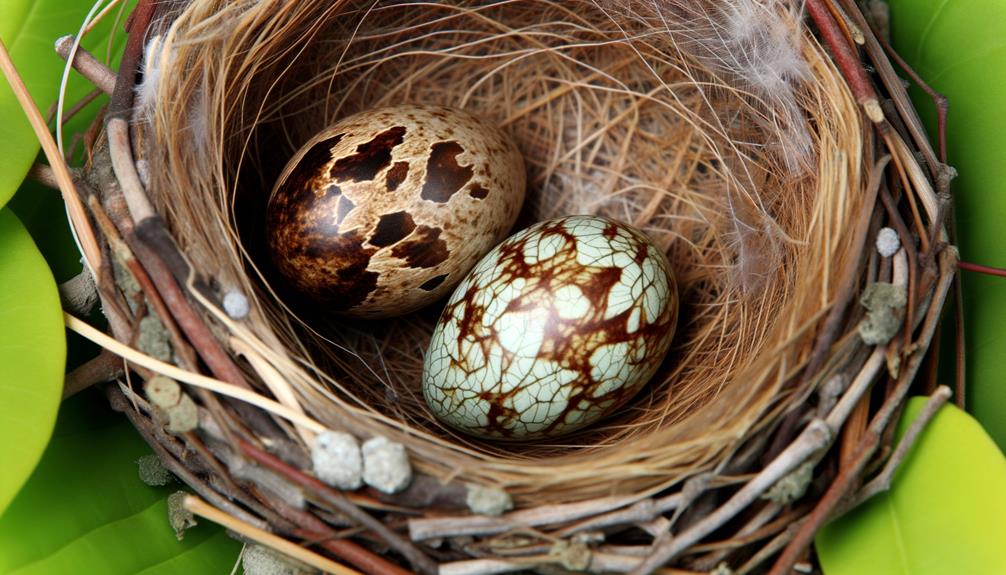
Key Takeaways
- Sparrow eggs are larger, measuring 18-22 mm in length, whereas wren eggs are smaller, around 12-16 mm in length.
- Sparrow eggs exhibit pale blue to white color with brown speckles, while wren eggs range from white to pinkish with reddish-brown speckles.
- House Sparrows prefer urban settings like building eaves, while House Wrens choose wooded areas and gardens for nesting.
- Sparrow nests are bulky and disorganized, constructed from coarse materials; wren nests are neater, using twigs, grasses, and feathers.
- Wren eggs display diverse markings, from fine speckles to larger spots, whereas sparrow eggs have more uniform coloration with subtle speckling.
Size Differences
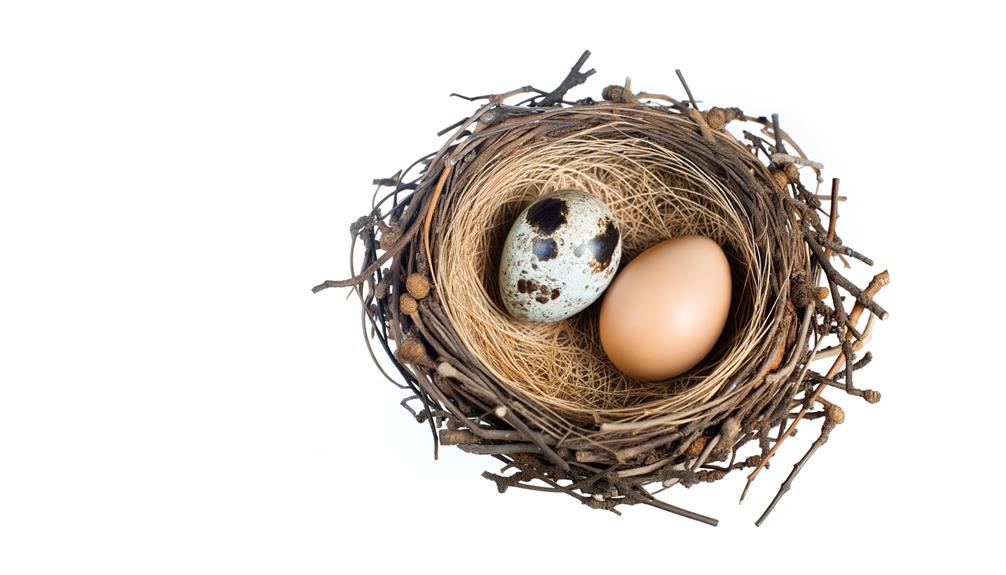
The size differences between sparrow eggs (Passeridae) and wren eggs (Troglodytidae) are notable, with sparrow eggs generally being larger in both length and diameter. In Passeridae, egg dimensions typically range from 18-22 mm in length and 13-15 mm in diameter.
Conversely, Troglodytidae eggs are smaller, measuring approximately 12-16 mm in length and 10-12 mm in diameter. These measurements are significant for ornithologists and avian enthusiasts for accurate species identification.
The larger size of sparrow eggs can be attributed to the overall body size and reproductive strategies of the species within Passeridae. Detailed morphometric analyses aid in distinguishing between the two families, ensuring precise identification and enhancing our understanding of avian reproductive biology.
Color Variations
Color variations between sparrow (Passeridae) and wren (Troglodytidae) eggs are marked by distinct hue differences, speck patterns, and eggshell textures.
Sparrow eggs typically exhibit a more uniform coloration, ranging from pale blue to white, often adorned with brown speckles.
In contrast, wren eggs usually display a broader spectrum of background hues, from white to pinkish, and are densely covered with reddish-brown speckles, contributing to their unique identification markers.
Hue Differences
Frequently, the hue of sparrow eggs shows a range from pale blue to grayish-white, often speckled with brown or black markings, whereas wren eggs typically display a creamy white or pinkish tone, adorned with reddish-brown spots concentrated at the larger end.
Importantly, sparrow eggs (Passeridae family) show significant color variation, aiding in camouflage within diverse nesting environments. Conversely, wren eggs (Troglodytidae family) maintain a more uniform coloration, facilitating identification.
These chromatic differences are essential for ornithologists in the field, as egg coloration can be indicative of species-specific nesting habits and environmental adaptations. Meticulous observation of these hue variations allows for accurate species identification, aiding in ecological studies and conservation efforts.
Speck Patterns
In addition to hue differences, the speck patterns on sparrow and wren eggs provide critical taxonomic markers. Sparrow eggs (Passeridae family) often exhibit irregular and scattered markings, while wren eggs (Troglodytidae family) show more consistent and densely packed speckles, mainly at the broader end.
Detailed observations reveal that sparrow eggs may display speckles in varying shades of browns and grays, lacking uniformity. Conversely, wren eggs typically exhibit a more homogenous pattern, with speckles concentrated mainly at the larger pole, forming a cap-like appearance.
This distinct speckling can assist in distinguishing between the two avian families, serving as a reliable characteristic for both ornithologists and enthusiasts involved in field identification.
Eggshell Texture
Exhibiting subtle color variations, the eggshells of sparrows and wrens differ not only in pigment but also in texture, providing additional clues for accurate identification. Sparrows (Passeridae) typically display a smoother eggshell surface with hues ranging from pale blue to grayish-white. In contrast, wrens (Troglodytidae) often exhibit a coarser texture, with colors spanning from creamy white to pinkish-brown. These textural differences are significant for ornithologists and avian enthusiasts seeking precise identification.
| Feature | Sparrow Eggs | Wren Eggs |
|---|---|---|
| Texture | Smooth | Coarse |
| Base Color | Pale blue, grayish-white | Creamy white, pinkish-brown |
| Speckles | Sparse, fine | Dense, varied |
| Glossiness | Moderate | Low |
| Shell Thickness | Thin | Slightly thicker |
Understanding these distinctions aids in the field identification and study of these avian species.
Egg Markings
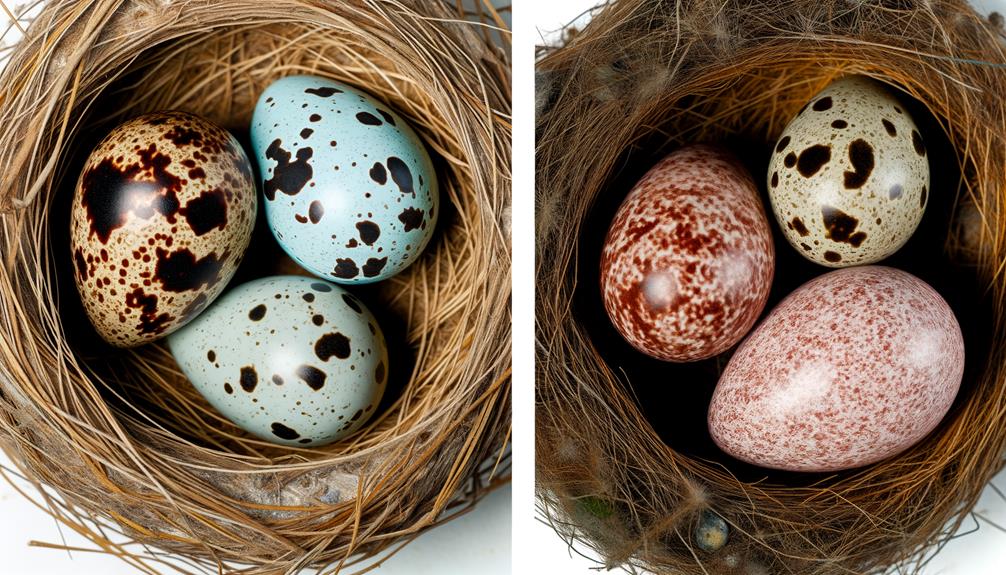
Egg markings present an essential distinguishing feature between sparrow (Passeridae) eggs and wren (Troglodytidae) eggs, characterized by variations in color patterns, speckling, and pigmentation.
Passeridae eggs generally exhibit a more uniform coloration, often with subtle speckling or blotching in shades of brown or gray. In contrast, Troglodytidae eggs tend to display more pronounced and diverse markings, ranging from fine speckles to larger spots. These markings can vary widely in hue, including reddish-brown, purplish, or even blackish tones.
Such pigmentation differences are vital for species identification and may also play roles in camouflage and thermoregulation. Detailed observation of these markings can provide valuable insights into the reproductive strategies and environmental adaptations of these avian taxa.
Nesting Locations
The nesting locations of sparrows (Family: Passeridae) and wrens (Family: Troglodytidae) exhibit distinct preferences that facilitate precise identification.
Common nesting sites for sparrows often include well-concealed areas within dense shrubbery or eaves of buildings, whereas wrens typically select enclosed cavities or niches, frequently at lower heights.
Additionally, the surrounding habitat plays an essential role, with sparrows favoring urban and suburban environments and wrens showing a propensity for more wooded or natural settings.
Common Nesting Sites
Sparrows typically choose nesting sites in dense shrubbery or tree cavities, while wrens prefer secluded locations such as crevices in walls, birdhouses, or thick vegetation. These distinct preferences can be attributed to their evolutionary adaptations and ecological requirements.
Passer domesticus (House Sparrow) often selects sites that provide ample cover and proximity to human activity, ensuring food availability. Conversely, Troglodytes aedon (House Wren) opts for more concealed areas to minimize predation risks.
Key nesting site characteristics include:
- House Sparrows:
- Dense shrubs or tree cavities
- Proximity to human dwellings
- House Wrens:
- Crevices in natural or artificial structures
- Dense vegetation away from open areas
Understanding these nesting preferences can aid in correctly identifying and conserving these species' habitats.
Nesting Height Preferences
Considering their distinct nesting site preferences, it is remarkable that Passer domesticus typically constructs nests at heights ranging from ground level up to approximately 30 feet, whereas Troglodytes aedon frequently nests at lower elevations, often between 3 to 10 feet above the ground.
This variation in vertical nesting stratification is indicative of their differing ecological adaptations and predator avoidance strategies. Passer domesticus, known for its adaptability, occupies higher and more varied elevations, utilizing both natural and artificial structures.
Conversely, Troglodytes aedon demonstrates a preference for lower nesting sites, often within dense vegetation or human-made cavities. These differential nesting height preferences are critical for avian ecologists to understand species-specific behaviors and to accurately identify nesting sites during field observations.
Habitat Surroundings
Ecologically distinct habitats are preferred by Passer domesticus and Troglodytes aedon for establishing their nesting sites, reflecting their unique adaptive strategies and environmental requirements.
Passer domesticus, commonly known as the House Sparrow, frequently selects urban and suburban regions, utilizing man-made structures for nesting. They nest in crevices of buildings, under eaves, and in birdhouses.
In contrast, Troglodytes aedon, or the House Wren, favors more natural settings such as wooded areas, gardens, and shrublands. They prefer sites within dense foliage, tree cavities, and birdhouses in gardens.
Urbanization impacts Passer domesticus more noticeably, while Troglodytes aedon adapts to both wild and semi-domesticated landscapes.
These habitat preferences underscore their distinct ecological niches.
Nest Characteristics
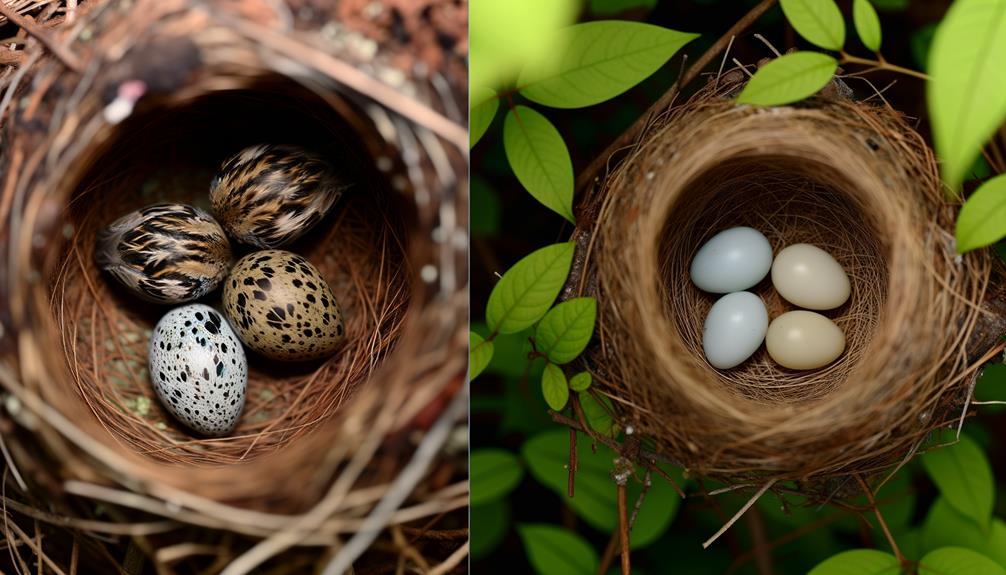
The architectural design of nests provides essential insights for distinguishing between the eggs of Passer domesticus (House Sparrow) and Troglodytes aedon (House Wren).
House Sparrows typically construct their nests in cavities or eaves, utilizing coarse materials such as grasses, feathers, and paper. Their nests exhibit a bulky, disorganized structure.
In contrast, House Wrens prefer enclosed spaces such as tree cavities or nest boxes, crafting nests from twigs, grasses, and feathers, which they compact into a cup shape. House Wren nests are characteristically neater, with a defined inner cup to house the eggs.
Understanding these structural differences aids in accurately identifying the species based on nest architecture, providing a non-invasive method for ornithological studies and birdwatching enthusiasts.
Observation Tips
Accurate identification of Passer domesticus and Troglodytes aedon eggs necessitates meticulous attention to coloration, patterning, and size, which are subtle yet definitive markers of species differentiation.
Passer domesticus eggs are generally white to grayish, often speckled with fine brown spots, and measure approximately 20 mm in length.
In contrast, Troglodytes aedon eggs are typically pinkish-white, adorned with reddish-brown speckles, and slightly smaller, around 17 mm.
Key observation tips include:
- Coloration: Compare the base color and speckling patterns.
- Size: Measure egg dimensions accurately using calipers.
- Location: Assess the nest environment as it influences egg characteristics.
Conclusion
To sum up, the distinctions between sparrow eggs and wren eggs are monumental, encompassing significant variations in size, color, and markings, as well as divergent nesting locations and nest characteristics.
Such differences are not mere trivialities but are profound indicators of the unique evolutionary paths taken by these avian taxa.
Observational diligence is paramount for accurate identification, underscoring the necessity for precision in ornithological studies.
The complexity of these distinctions cannot be overstated, demanding meticulous attention to detail from researchers.

